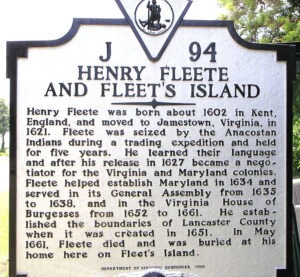
Many locations around the Northern Neck area carry the name Fleet (Fleet’s Island, Fleet’s Bay, and Fleeton just to name a few.) The man behind the prominent name is Henry Fleete, an Englishman that immigrated to Jamestown, Virginia in 1621.
In 1623, Fleete was engaged in business and trading aboard a vessel named the Tiger that was set to navigate from Jamestown to the Upper Potomac. The goal of the trip was to trade corn for other goods but when the captain and the 21 crew members went ashore, they were brutally attacked by the Anacostan Indians. Many were killed and some, including Fleete, were captured. Henry Fleete was held hostage for around four years and during that time he learned the language used by the Anacostan tribe members.
Henry was eventually ransomed and released and decided to use the knowledge he had acquired of the people and their language to act as an interpreter and mediator between the English and the Native Americans. He also was engaged in the fur trade at this time.
In 1634 Fleete offered his services to Lord Baltimore and aided in the expedition into Maryland. As payment, Fleet was granted 4,000 acres in Maryland on the St. Georges River. He settled the land and in 1638 served in the Maryland Assembly.
In the 1640s Lord Baltimore took control over the Maryland fur trade industry and Henry decided to return to Virginia. He was granted fur-trading rights west of the James River. Over the next years, he was commissioned for other jobs with Lord Baltimore, and by 1650, he held a patent for 1750 acres of land in Northumberland County, which is now known as Fleet’s Bay. In 1652 he was granted over 950 acres in Lancaster County. He established a plantation near Windmill Point on the island that now bears his name and remained there until his death.
A historical marker is placed on the island paying homage to its namesake. It reads:
“Henry Fleete was born about 1602 in Kent, England, and moved to Jamestown, Virginia, in 1621. Fleete was seized by the Anacostan Indians during a trading expedition and held for five years. He learned their language and after his release in 1627 became a negotiator for the Virginia and Maryland colonies. Fleete helped establish Maryland in 1634 and served in its General Assembly from 1635 to 1638, and in the Virginia House of Burgesses from 1652 to 1661. He established the boundaries of Lancaster County when it was created in 1651. In May 1661, Fleete died and was buried at his home here on Fleet’s Island.”





